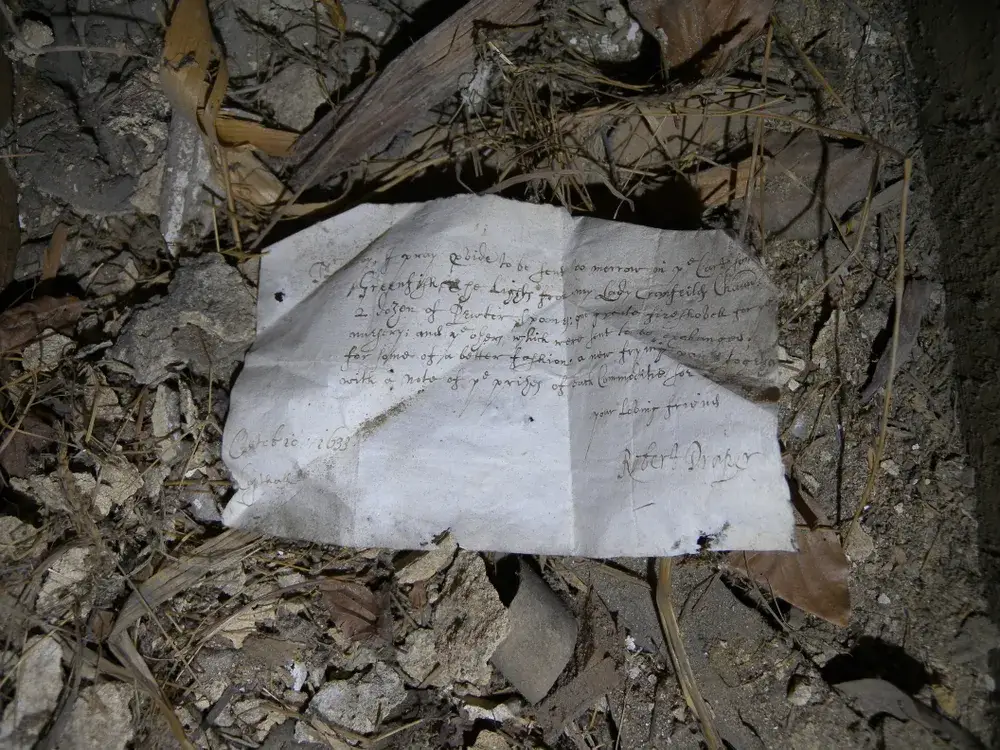
Seventeenth-Century Shopping List Discovered Under Floorboards of Historic English Home
Penned in 1633, the “beautifully written” list hints at household life 400 years ago
By: Brigit Katz | Smithsonian
Pewter spoons, a frying pan and “greenfish”—these must-have items were scribbled on a shopping list 400 years ago. The scrap of paper was recently discovered under the floorboards of Knole, a historic country home in Kent, England.
As Oliver Porritt reports for Kent Live, Jim Parker, a volunteer working with the archaeology team at Knole, discovered the 1633 note during a multi-million dollar project to restore the house. The team also found two other 17th century letters nearby. One, like the shopping list, was located under the attic floorboards; another was stuffed into a ceiling void.
The shopping list was penned by Robert Draper and addressed to one Mr. Bilby. According to the UK’s National Trust, the note was “beautifully written,” suggesting that Draper was a high-ranking servant. In addition to the aforementioned kitchenware and greenfish (unsalted cod), Draper asks Mr. Bilby to send a “fireshovel” and “lights” to Copt Hall (also known as Copped Hall), an estate in Essex.
Alien “City” Found On The Moon State UFOlogists: Here Is How To Find It Yourself
The full text reads:
Mr Bilby, I pray p[ro]vide to be sent too morrow in ye Cart some Greenfish, The Lights from my Lady Cranfeild[es] Cham[ber] 2 dozen of Pewter spoon[es]: one greate fireshovell for ye nursery; and ye o[t]hers which were sent to be exchanged for some of a better fashion, a new frying pan together with a note of ye prises of such Commoditie for ye rest.
Your loving friend
Robert Draper
Octobre 1633
Copthall

How did this rather mundane domestic letter come to be stashed in an attic at Knole, which is some 36 miles away from Copt Hall? As the National Trust explains, Copt Hall and Knole merged when Frances Cranfield married Richard Sackville in 1637. Cranfield was the daughter of the Earl of Middlesex, who owned Copt Hall; Sackville, the 5th Earl of Dorset, had inherited Knole, his family’s home.
Household records indicate that large trunks filled with domestic items—including various papers—were moved from Copt Hall to Knole at the time of the marriage, and subsequently stored in the attic. Draper’s note may have slipped under the floorboards.
The marriage of Cranfield and Sackville was important for Knole, according to the National Trust Collections, because Cranfield inherited a trove of expensive paintings and furniture from her father. Draper’s letter certainly was not among the more prized items that Cranfield brought to the marriage, but for modern-day historians, it is exceptionally valuable.
“It’s extremely rare to uncover letters dating back to the 17th century, let alone those that give us an insight into the management of the households of the wealthy, and the movement of items from one place to another,” Nathalie Cohen, regional archaeologist for the National Trust, tells Porritt. She added that the good condition of both the list and the two other letters found at Knole “makes this a particularly exciting discovery.”
* * *
NEXT UP!
Gobekli Tepe: The World’s First Temple?
Six miles from Urfa, an ancient city in south-eastern Turkey, Klaus Schmidt has made one of the most startling archaeological discoveries of our time: massive carved stones about 11,000 years old, crafted and arranged by prehistoric people who had not yet developed metal tools or even pottery. The megaliths predate Stonehenge by some 6,000 years.
The place is called Gobekli Tepe, and Schmidt, a German archaeologist who has been working here more than a decade, is convinced it’s the site of the world’s oldest temple.
* * *
READ MORE: This Ancient Maya City Was Hidden In The Jungle For More Than 1,000 Years
More Archaeology News: Guanches: Ancient Mummies of The Canary Islands (Video)
Enjoyed it? Please take a moment to show your support for Collective Spark.
We’d love to hear from you! If you have a comment about this article or if you have a tip for a future Collective Spark Story please let us know below in the comment section.
